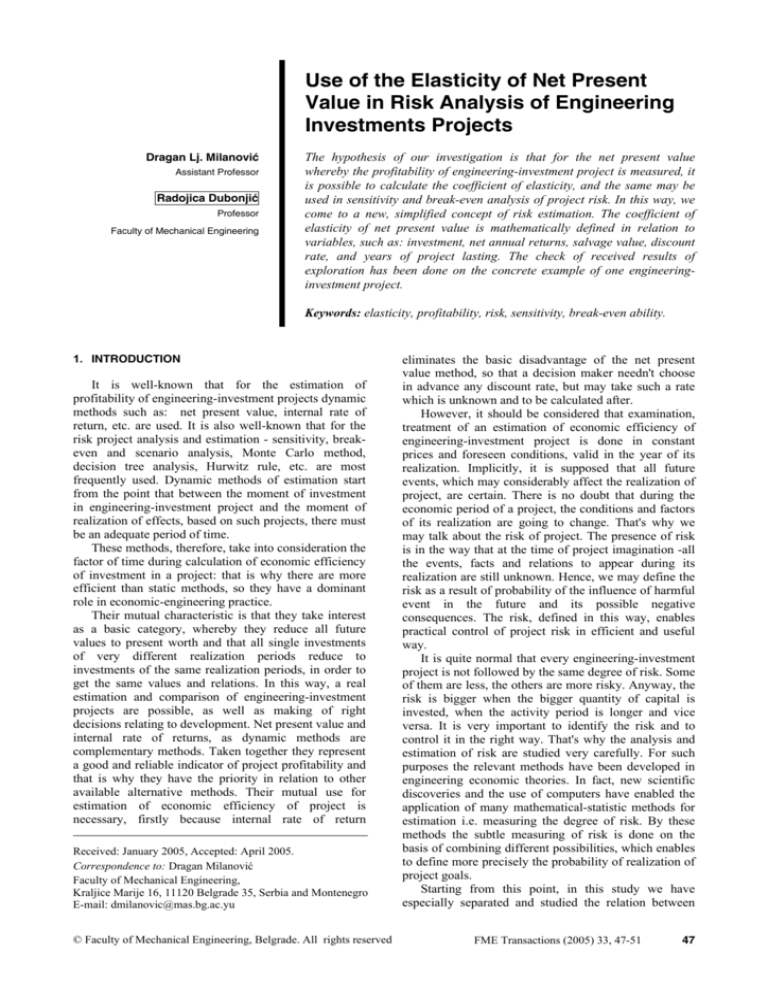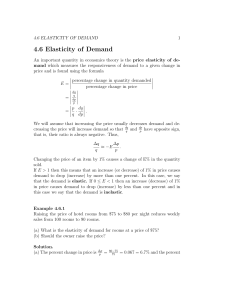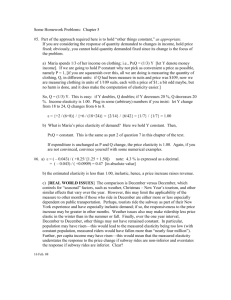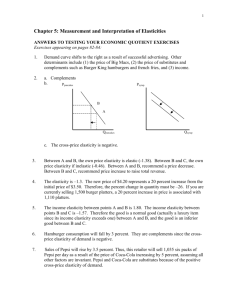
Use of the Elasticity of Net Present
Value in Risk Analysis of Engineering
Investments Projects
Dragan Lj. Milanović
Assistant Professor
Radojica Dubonjić
Professor
Faculty of Mechanical Engineering
The hypothesis of our investigation is that for the net present value
whereby the profitability of engineering-investment project is measured, it
is possible to calculate the coefficient of elasticity, and the same may be
used in sensitivity and break-even analysis of project risk. In this way, we
come to a new, simplified concept of risk estimation. The coefficient of
elasticity of net present value is mathematically defined in relation to
variables, such as: investment, net annual returns, salvage value, discount
rate, and years of project lasting. The check of received results of
exploration has been done on the concrete example of one engineeringinvestment project.
Keywords: elasticity, profitability, risk, sensitivity, break-even ability.
1. INTRODUCTION
It is well-known that for the estimation of
profitability of engineering-investment projects dynamic
methods such as: net present value, internal rate of
return, etc. are used. It is also well-known that for the
risk project analysis and estimation - sensitivity, breakeven and scenario analysis, Monte Carlo method,
decision tree analysis, Hurwitz rule, etc. are most
frequently used. Dynamic methods of estimation start
from the point that between the moment of investment
in engineering-investment project and the moment of
realization of effects, based on such projects, there must
be an adequate period of time.
These methods, therefore, take into consideration the
factor of time during calculation of economic efficiency
of investment in a project: that is why there are more
efficient than static methods, so they have a dominant
role in economic-engineering practice.
Their mutual characteristic is that they take interest
as a basic category, whereby they reduce all future
values to present worth and that all single investments
of very different realization periods reduce to
investments of the same realization periods, in order to
get the same values and relations. In this way, a real
estimation and comparison of engineering-investment
projects are possible, as well as making of right
decisions relating to development. Net present value and
internal rate of returns, as dynamic methods are
complementary methods. Taken together they represent
a good and reliable indicator of project profitability and
that is why they have the priority in relation to other
available alternative methods. Their mutual use for
estimation of economic efficiency of project is
necessary, firstly because internal rate of return
Received: January 2005, Accepted: April 2005.
Correspondence to: Dragan Milanović
Faculty of Mechanical Engineering,
Kraljice Marije 16, 11120 Belgrade 35, Serbia and Montenegro
E-mail: dmilanovic@mas.bg.ac.yu
© Faculty of Mechanical Engineering, Belgrade. All rights reserved
eliminates the basic disadvantage of the net present
value method, so that a decision maker needn't choose
in advance any discount rate, but may take such a rate
which is unknown and to be calculated after.
However, it should be considered that examination,
treatment of an estimation of economic efficiency of
engineering-investment project is done in constant
prices and foreseen conditions, valid in the year of its
realization. Implicitly, it is supposed that all future
events, which may considerably affect the realization of
project, are certain. There is no doubt that during the
economic period of a project, the conditions and factors
of its realization are going to change. That's why we
may talk about the risk of project. The presence of risk
is in the way that at the time of project imagination -all
the events, facts and relations to appear during its
realization are still unknown. Hence, we may define the
risk as a result of probability of the influence of harmful
event in the future and its possible negative
consequences. The risk, defined in this way, enables
practical control of project risk in efficient and useful
way.
It is quite normal that every engineering-investment
project is not followed by the same degree of risk. Some
of them are less, the others are more risky. Anyway, the
risk is bigger when the bigger quantity of capital is
invested, when the activity period is longer and vice
versa. It is very important to identify the risk and to
control it in the right way. That's why the analysis and
estimation of risk are studied very carefully. For such
purposes the relevant methods have been developed in
engineering economic theories. In fact, new scientific
discoveries and the use of computers have enabled the
application of many mathematical-statistic methods for
estimation i.e. measuring the degree of risk. By these
methods the subtle measuring of risk is done on the
basis of combining different possibilities, which enables
to define more precisely the probability of realization of
project goals.
Starting from this point, in this study we have
especially separated and studied the relation between
FME Transactions (2005) 33, 47-51
47
net present value method and sensitivity and break-even
analysis for the purpose of project risk estimation. The
use of these methods understands the application of
complex economic and mathematical statistical analysis.
While by the sensitivity analysis the most important
variables are identified, which affect most the final
result of investment, at the same time by the break-even
analysis the effects of variations in results of net present
value are studied. At the same time, it has been
ascertained that between these two methods it is
possible to make direct connection by net present value.
The hypothesis of our exploration is that for net present
value it is possible to calculate the coefficient of
elasticity and to use the same in sensitivity and breakeven analysis and in project risk estimation. In this way
we have come to a very simplified measuring of project
risk degree.
Hence, continued on the following pages of this
study, in the order of presentation, there follow:
- calculation of coefficient of elasticity of net present
value,
- calculation of coefficient of elasticity of net present
value in relation to investment,
- calculation of coefficient of elasticity of net present
value in relation to net annual returns,
- calculation of coefficient of elasticity of net present
value in relation to salvage value of project,
- calculation of coefficient of elasticity of net present
value in relation to discount rate,
- calculation of coefficient of elasticity of net present
value in relation to years of project lasting,
- the use of net present value elasticity in sensitivity
and break-even analysis,
- illustration of got coefficients of elasticity on the
selected concrete example.
quotient of net present value relative changes and
adequate relative changes of a considered variable ( x )
when their increasing inclines to zero:
∆S
x
∆S
x ∂S
E ( x ) = ± lim S = ± lim
=±
. (2)
∆
x
S ∆x→0 ∆x
S ∂x
∆x→0
x
In such a case the mark (+) is taken for those
variables, as independent variables for which the
function is increasing and vice versa, the mark () is
being taken for the variables for which the function is
declining.
In further examination of this problem we shall keep
to the above-mentioned five variables, which the project
net present value depends on most frequently:
1. investment ( I ),
2. net annual returns ( A ),
3. salvage value ( L ),
4. rate of interest (discount) ( k ),
5. years of project lasting ( n ).
2. COEFFICIENT OF ELASTICITY OF NET PRESENT
VALUE
2. Elasticity coefficient of net present value in relation
to net annual returns:
The elasticity of net present value may be defined as
a relation of relative net present value variations and
relative variations of adequate variables, which affects
net present worth, such as: revenues ( R ), operative
costs ( C ), investments ( I ), salvage value ( L ), rate of
interest (k), number of years of projects exploitation (n),
etc. Net present value function of a.m. variables may be
expressed as:
S = −I + A
(1 + k ) n − 1
+
L
.
(1)
n
k (1 + k )
(1 + k )
S - net present value of project, A -net annual returns of
project, i.e. A = R − C .
Each of these variables, by changing of its values,
affects more or less the variation of net present value. If
we mark the variable to change with x , then S = f ( x ) .
Let's say that the function is limited and endless in a
certain interval. Let's mark with ∆x the increasing
certain variable, and with ∆ S the increasing of net
n
present worth in the same interval, then ∆x / x is the
relative change of a considered variable, and ∆S / S is
the relative change of net present worth. The elasticity
of net present worth is then defined as an edge value of
FME Transaction
Now we are going to calculate the elasticity
coefficient of net present value for each of these
variables, taking such variable as an independent
variable, and the other variables as constants.
1. Elasticity coefficient of net present value in relation
to investment:
I ∂S
E =−
,
(I )
S ∂I
(function S = f ( I ) is declining so the mark (-) is being
taken). Because of ∂S / ∂I = −1 , then
E( I ) =
I
.
S
E( A) =
n
(3)
A ∂S
,
S ∂A
n
∂S (1 + k ) − 1
A (1 + k ) − 1
.
=
⇒ E( A) =
n
∂A
S
k (1 + k )
k (1 + k ) n
(4)
3. Elasticity coefficient of net present value in relation
to salvage value:
L ∂S
,
E( L ) =
S ∂L
∂S
1
L
.
(5)
=
⇒ E( L ) =
n
∂L (1 + k ) n
S (1 + k )
4. Elasticity coefficient of net present value in relation
to discount rate:
k ∂S
,
E =−
(k )
S ∂k
∂S
n
1
1
n
,
= A
+
−
−L
n
+
1
2
n
2
∂k
k (1 + k )
k
(1 + k ) n+1
k (1 + k )
E(k ) =
L⋅k
n
A⋅k
n
−
+
n
+
1
S (1 + k )
S k (1 + k ) n+1
VOL. 33, No 1, 2005 ▪ 48
+
1
k 2 (1 + k ) n
−
1
.
k 2
(6)
5. Elasticity coefficient of net present value in relation
to years of project lasting:
E( n ) =
n ∂S
,
S ∂n
∂S A
ln(1 + k )
⇒
= − L
∂n k
(1 + k ) n
n( A − L ⋅ k ) ln(1 + k )
E(n) =
⋅
.
S ⋅k
(1 + k ) n
(7)
3. USE OF E(x) IN SENSITIVITY AND BREAK-EVEN
ANALYSIS
Sensitivity and break-even analysis are the two
most frequently used methods in defining risk in
engineering economy. Sensitivity analysis defines the
influence of variables, such as: revenues, costs, salvage
value, etc. which are used in estimation of cash flows on
net present value of the project. It discovers how much
the net present value will change, depending on such
variables changing.
Sensitivity analysis starts from the "basic case" got
by using the most probable values for each variable. A
certain variable is changed for a certain percentage
above and below the most probable value, keeping the
other variables constant. Afterwards, the net present
value is calculated for each of these values. For the sake
of better view, it is desirable for all the results to be
written tabular. In addition, a favorable and useful way
to express the results of sensitivity analysis is graphic
description. The incline of the line represents how much
the net present worth is sensitive to the changing of each
variable - the bigger the incline, the more sensitive the
net present value is to the changing of certain variable.
In this way we can identify the most important
variables, i.e. the elements of cash flow that affect most
the final results of investment.
When doing sensitivity analysis of the project, it is
questionable what the final effect will really be, for
example, of lower incomes and higher costs. The
answer to the question is how much the sale of product
within the concrete investment project may fall below
the foreseen before the project starts making loss, for is
calculated by break-even analysis. In other words,
break-even analysis is a technique for the study of
variations effects on the result of the net present value
of project.
The procedure of break-even analysis starts by
taking one of the variables (revenues, costs, i.e. net
returns, investment, salvage value, etc.) as an unknown
variable ( x ). Then the present value of all incoming
cash flows of projects (inflows) is represented as one
function of the unknown variable - S u = f1 ( x) , while
the present value of all out coming cash flows
(outflows) as other function of x - S i = f 2 ( x) . Net
present value is the difference between these two
FME Transaction
functions, and break-even value of x is got when the
net present value equals zero, i.e. from the equation
f1 ( x ) = f 2 ( x ) .
Instead of this "classical" analysis of project risk by
these two methods, in this study we have tried to apply
the elasticity of net present value for the sake of faster
and simpler getting of the results of such an analysis. By
the equations (3) - (7) we calculate the elasticity
coefficient of net present value in relation to certain
variables. Thus calculated coefficient values afterwards
are ordered according to their size and in this way we
get immediately the view of sensitivity of net present
value in relation to these variables. In fact, the bigger
coefficient value, the more sensitive net present value is
to the changing of variable represented by such
coefficient.
The received elasticity coefficient value for a certain
variable represents, in fact, the percentage of net present
worth change, when that variable changes by 1%.
Knowing that, it is easy to calculate the new net present
value, as a result of value change of that variable, by
multiplying of its starting value by the number, which is
being got as a sum or difference (depending on variable,
as explained before) of 100% and elasticity coefficient,
multiplied previously by the percentage of variable
change:
(8)
S1 = S (100% ± E ( x ) p) ,
where " p " is the percentage of considered variable
change, S1 is the new net present value that arose as the
consequence of considered variable change by " p "
percentage.
For example, let the considered variable be
investment ( I ) and let's say that with its value of
100 000 $ $ we got net present value S = 50 000 $ . If
the calculated elasticity coefficient E (I ) , for example,
is 3,4 that means that with changing of investment value
by 1% net present value will change by 3,4%. However,
since during the analysis we are most frequently
interested in variable changes of ±5 % , ±10 % , ±15 %
etc., we will come to the new net present value putting
in equation (8) for " p " values ±5 % , ±10 % , ±15 %
etc. In this concrete case if we change the value of
investment by 5 % ( 105 000 ) then the new net present
value will be: S1 = 50, 000(100% − 3, 4 ⋅ 5%) = 41500 $ .
For the break-even analysis, instead of making new
equations and new tables, using the explained method,
we come very fast to a solution, i.e. to break-even value
of considered variables in the following way: in
equation (8) S1 equals zero and look for break-even
value of percentage change of a considered variable
p k , and we get the break-even value of variable x k by
multipling its starting value by ( 100% + p k ):
0 = S (100% ± E ( x ) p k ) ⇒ p k = ∓
100%
,
E( x)
x k = x(100 % + p k ) .
(9)
(10)
VOL. 33, No 1, 2005 ▪ 49
In our example break-even value of investment would
be:
100%
pk =
= 25,71% ⇒
3,4
I k = 100 000 ⋅ 1,2571 = 125 710 $ .
4. EXAMPLE
As an illustration of all the above said, we are going
to present the use of net present value elasticity in
sensitive and break-even analysis on one concrete
example: on the basis of given data about one
engineering investment project, it is necessary to
examine the project net present value sensitivity to the
affecting elements of cash flows and to ascertain the
break-even value of the most affecting variable, i.e. of
the variable to whose changes net present value is the
most sensitive.
Based on the overall analysis, the following values
of money flows elements have been estimated: the
investment in a project would be 8 000 $ what would
give net annual returns of 3 000 $ in the next 5 years.
The salvage project value after 5 years of exploitation
has been estimated to 0 $ , and the discount rate for the
following period to 15% annually.
The first step is to calculate the net present value of
the project for given variables. By using equations (1)
we get:
S = −I + A
(1 + k ) n − 1
k (1 + k )
= −8 000 + 3 000
n
+
L
(1 + k ) n
(1 + 0,15) 5 − 1
0,15(1 + 0,15) 5
=
= 2 056 $ .
The next step is to calculate the net present value
elasticity coefficient in relation to four given variables.
By using equations (3) to (7), we easily come to the
coefficient value. For example, herewith we are going to
present only the calculation of net present value
coefficient in relation to net annual returns:
E ( A) =
A (1 + k ) n − 1 3 000 (1,15) 5 − 1
=
⋅
= 4,89 .
2 056 0,15(1,15) 5
S k (1 + k ) n
The other elasticity coefficients are as follows:
E ( I ) = 3,89 ,
E ( n ) = 3,38 ,
E ( k ) = 1,74 .
On the basis of these results, we get quite clear view of
net present value sensitivity to the changes of each cash
flows elements of the project. It is quite evident that the
variable, whose variations affect most the net present
value, is the net annual returns of the project. So, for
example, the variation of net annual returns by ±15 %
would result in variation of net present value by
±73,35 % ( 4,89 ⋅ 15% ). In other words if, during
project exploitation, the estimated returns of 3 000$
FME Transaction
annually don't realize, but
15 % amounting to 2 550 $
unfavorable circumstances,
will "fall" to $ 548 $
the same are reduced by
annually, due to unforeseen
then the net present value
[ S1 = S (100% ± E ( x ) p ) =
2 056(100 % − 4,89 ⋅ 15 %) = 548 $ ].
Net present value is a bit less sensitive to the
variations of investment values and number of years of
project exploitation, while it is least sensitive to the
possible variations of discount rate values.
One more fact to be established is what is the breakeven value of the most affecting variable, i.e. net annul
returns, to the net present value, below which the
project would produce losses. By using the equations
(9) and (10) we come to:
pk = ∓
100%
100%
=−
= −20,45% ,
E ( A)
4,89
Ak = A[100% + (−20,45%)] = 2 387 $.
That means that any net annul returns of a project being
below 2 387 $ would produce losses; that is why such a
project would not be acceptable.
5.
CONCLUSION
The results of these explorations, we have come to
in this study, undoubtedly indicate that the net present
value elasticity may be used in the analysis and
estimation of risk in engineering investment projects.
By the calculated elasticity coefficients, a direct
connection is made between net present value and
sensitivity and break-even analysis method during risk
estimation. In this way, we come to a new, very
simplified procedure for risk estimation i.e. measuring.
It is enough on the basis of given equations, to calculate
the values of elasticity coefficient, then to order them
according to their size and in this way come to fact of
net present value sensitivity in relation to variables,
such as: investment, net annual returns, salvage value of
project, discount rate and the years of project lasting. A
higher value of elasticity coefficient indicates that the
net present value is more sensitive to the variation of
variable, represented by such a coefficient. Based on
these facts, it is easy to calculate a new net present value
by the following equation:
S1 = S (100% ± E ( x ) p ) .
Furthermore, it should be pointed out, that in breakeven analysis too, instead of setting new equations and
making new tables by using net present value elasticity,
we come very fast to the appropriate solution, i.e. to
break-even value of a considered variable, which has
been explicitly proved by equations 9 and 10.
Finally, on the basis of the data of one engineering
investment project the validity of presented, exploring
results has been checked. Thus, by this example on the
concrete project it has been presented that the use of net
present value elasticity in sensitivity and break-even
analysis has a great analytic value. All a.m. facts
indicate that in the adequate engineering investment
analysis, besides function elasticity, production
VOL. 33, No 1, 2005 ▪ 50
elasticity, elasticity of costs, revenues, supply and
demand we may also use the net present value elasticity.
REFERENCES
[1] Collier, C. A., Ledbetter, W. B.: Engineering
Economic and Cost Analysis, Harper & Row, New
York, 1988.
[2] Dubonjić, R., Milanović, D. Lj.: Engineering
Economy, Faculty of Mechanical Engineering,
Belgrade, 1997 (in Serbian).
[3] Dubonjić, R., Milanović, Lj.: Complementarities of
sensitive and critical analysis methods in
evaluation of investment projects in the process
industry, Procesna tehnika No 1, pp. 244-248,
march, 2002.
[4] Newnan, D.: Engineering Economic Analysis,
Engineering Press, Austin, Texas, 1998.
[5] Park, Ch.: Contemporary Engineering Economics,
Addison-Wesley Publishing Company, 1993.
[6] White, J. A., Agre, M. H., Case, K. E.: Principles
of Engineering Economics Analysis, Wiley, New
York, 1989.
[7] Young, D.: Modern Engineering Economy, John
Wiley & Sons, Inc., USA, 1993.
FME Transaction
ПРИМЕНА ЕЛАСТИЧНОСТИ НЕТО
САДАШЊЕ ВРЕДНОСТИ У АНАЛИЗИ
РИЗИКА ИНЖЕЊЕРСКИХ
ИНВЕСТИЦИОНИХ ПРОЈЕКАТА
Драган Љ. Милановић, Радојица Дубоњић
Претпоставка нашег истраживања је да се за нето
садашњу вредност, помоћу које се мери
профитабилност инжењерско - инвестиционог
пројекта,
може
израчунати
коефицијенат
еластичности и исти користити у сензитивној и
критичној анализи ризика пројекта. Тиме се долази
до новог, поједностављеног концепта оцене ризика.
Коефицијенат
еластичности
нето
садашње
вредности математички је одређен у односу на
променљиве, као што су: инвестиционо улагање,
нето годишње зараде, ликвидациона вредност
пројекта, дисконтна стопа и године трајања
пројекта. Провера добијених резултата истраживања
извршена је на конкретном примеру једног
инжењерског инвестиционог пројекта.
VOL. 33, No 1, 2005 ▪ 51
FME Transaction
VOL. 33, No 1, 2005 ▪ 52








